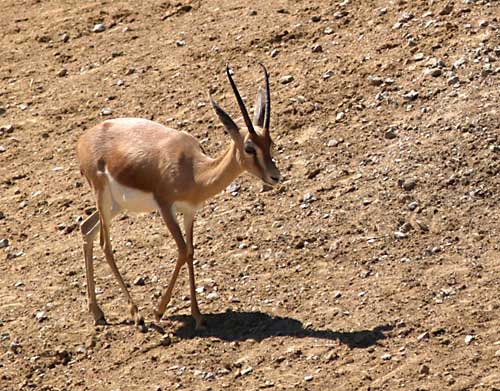Dorcas Gazelle (Gazella dorcas) - Wiki Dorcas Gazelle
From Wikipedia, the free encyclopedia
Order: Artiodactyla
Family: Bovidae
Subfamily: Antilopinae
[Photo] Dorcas Gazelle (Gazella dorcas) at Zoo Hannover, Germany. Date July 2006. Author: Frithjof Spangenberg.
The Dorcas Gazelle (Gazella dorcas) is not the smallest of the gazelles nor the most common, but it is small and it is common. The Dorcas Gazelle is 53 cm(21 inches). The numerous subspecies of the Dorcas Gazelle survive on vegetation in grassland, steppe, wadis, mountain desert and in semi-desert climates. The species ranges throughout Africa, Arabia and into Iran and northern India.
Description
The Dorcas gazelle is similar in appearance to, yet smaller than, the closely related Mountain Gazelle (Gazella gazella). Dorcas have longer ears and more strongly curved horns, which bow outwards then turn inwards and forwards at the tips. Individuals belonging to the Saharan subspecies (Gazella dorcas osiris) have a very pale fawn colored coat. The white underside is bordered with a brown stripe, above which there is a sandy stripe. The forehead and face are darker than the body. Subspecies from north of the Sahara tend to be more ochre in color, and have dark flanks and face-stripes. Populations in Israel and around the Red Sea are darker and more reddish. In the last century the dorcas gazella was totally destroyed in all the countries that was its subsistence, but only in Israel it survived. Now there are big populations of this gazella in the Negev and the Arava. Israel is the only hope to this beautiful subspecies. All over Israel there are between 1000-1500 gazella.
Behaviour
The Dorcas Gazelle is highly adapted to the desert. They can go their entire lives without drinking, as they can get all of the moisture they need from the plants in their diet, though they do drink when water is available. They are able to withstand high temperatures, but when it is very hot they are active mainly at dawn, dusk and during the night. In areas where they face human predation, they tend to be active only at night in order to minimise the risk of falling prey to hunters. These gazelles feed on leaves, flowers and pods of many species of Acacian trees, as well as the leaves, twigs and fruits of various bushes. They occasionally stand on their hind legs to graze on trees, and after rain they have been observed digging out bulbs from the ground. Dorcas Gazelles are able to run at speeds of up to 80 km per hour, and when threatened they tail-twitch and make bouncing leaps with the head held high (stotting) to announce that they have seen a predator.
Breeding
When conditions are harsh, Dorcas Gazelles live in pairs, but when conditions are more favorable they join together in family herds with one adult male, several females and young. During the breeding season, adult males tend to be territorial, and mark their range with dung middens. In most parts of their range, mating takes place from September to November. Gestation takes six months; a single fawn is typical, although twins have been reported in Algeria. The newborn is well developed at birth, with fur and open eyes. Within the first hour, the fawn attempts to stand, and it will suckle on this first day of life. In the first two weeks, the young gazelle lies curled up in a scrape on the ground or beneath bushes while the mother grazes close by. The young then starts to follow its mother around and begins to take solid food. After around three months, the fawn stops suckling and is fully weaned.
Threats
The population of this gazelle has declined throughout its range. The natural predators of Dorcas Gazelles include the cheetah, leopard, and the lion, but due to hunters, there aren't very many large cats left to eat them. The main threat to this species is ever-expanding civilization, which shrinks the gazelle's habitat by converting it to farmland for growing crops, and by introducing new flocks of domestic sheep and goats which compete with the gazelle for vegetation.
http://en.wikipedia.org/wiki/Dorcas_Gazelle
| The text in this page is based on the copyrighted Wikipedia article shown in above URL. It is used under the GNU Free Documentation License. You may redistribute it, verbatim or modified, providing that you comply with the terms of the GFDL. |
